Everyday VOC: Turn every customer visit into actionable insight
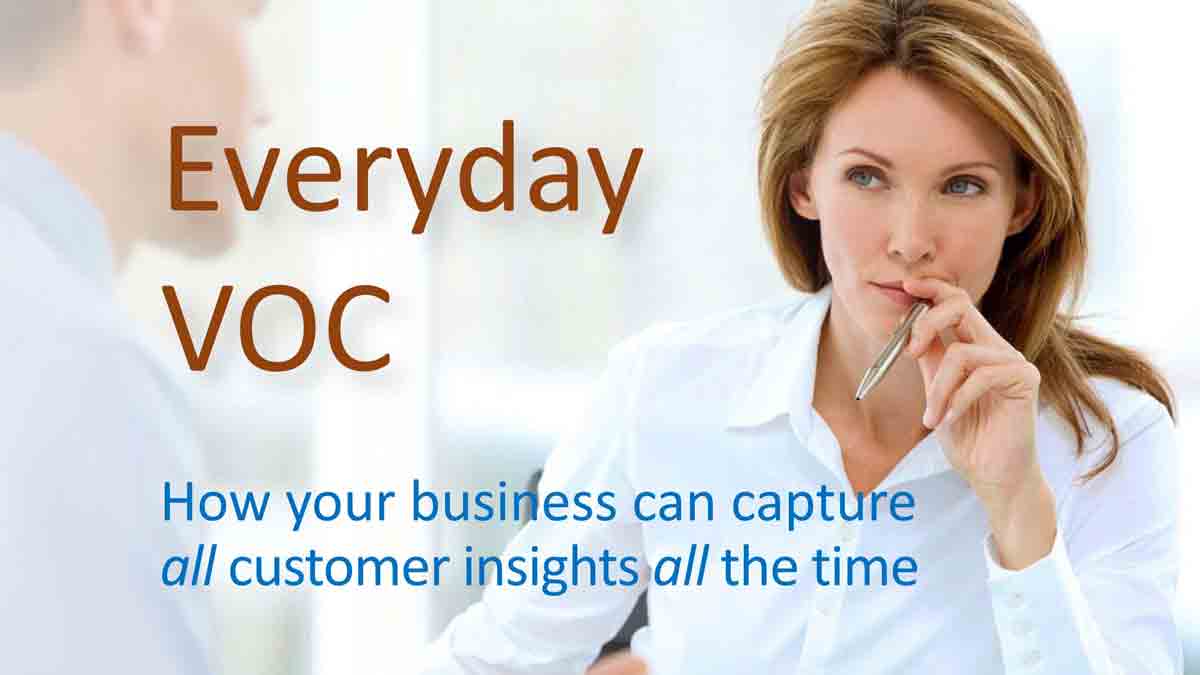
Do your sales and tech support reps make hundreds of customer calls annually? Why not train them to probe deeply and capture customer needs uniformly in your CRM? You’ll gain unprecedented market insight when you turn your sales force into a learning force—to help you develop better future products. And with Everyday VOC probing, they’ll sell more now.
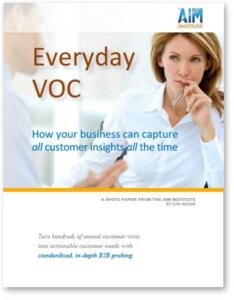
Your B2B customers have a long list of problems to be solved. But it’s not their job to carefully explain each one and deliver it gift-wrapped to your solution providers. It’s your job.
What if each of your customer-facing employees knew how to ask great probing questions… and then record customer insights in your CRM in a uniform, actionable manner? And what if their probing was so good, it led to more sales today? This is Everyday VOC.
You’d like to see market needs move seamlessly from the minds of your customers to your R&D, but valuable insights are often filtered out. Imagine what might be happening when your sales rep talks to a customer:
- Poor listening skills: Is your rep in the “broadcast mode” selling your product line, or are they eagerly listening to the problems the customer is facing?
- Few probing questions: When a problem surfaces, does your rep probe to learn when it happens, how often it happens, where it happens, the impact when it happens, and the value in preventing it?
- Haphazard call reports: Does your rep draw special attention to each customer need in his or her call report, or are they co-mingled with other information, e.g., competitive pricing, job changes, and industry news?
- Weak data mining: Can your marketing or product managers mine your CRM to detect weak signals of market needs before competitors, or is the data a mish-mash?
We’ll explain Everyday VOC—a simple but highly effective probing methodology your sales, tech support, and other customer-facing employees can employ. Then we’ll show how this leads to two major benefits for your business:
- Benefit #1: Everyday VOC probing helps your sales rep sell more during the customer call itself. It boosts sales now.
- Benefit #2: Everyday VOC probing provides uniform capture of needs for effective CRM data mining. It boosts sales later.
When your sales professional asks the question, “Tell me about your problems” and follows up with good probing, you’ll sell more now and more later.
Everyday VOC: A B2B-optimized probing method
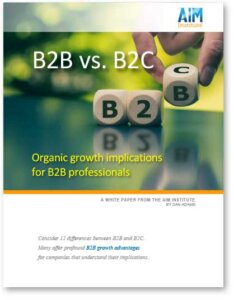 Some say, “customers can’t tell you what they want.” But they’ve missed two points. First, B2B customers can tell you much more about their needs than end-consumers. B2B customers tend to have more…
Some say, “customers can’t tell you what they want.” But they’ve missed two points. First, B2B customers can tell you much more about their needs than end-consumers. B2B customers tend to have more…
- Knowledge… from years of education, on-the-job training, and extensive thinking time.
- Interest… because your innovative new product could make them a hero at work.
- Objectivity… due to procedures, accountability, and multiple decision-makers & influencers.
- Foresight… since they are keenly aware of what’s needed to improve their profitability.
There are at least 12 differences between B2B and B2C. For a full description, download our white paper at www.b2bvsb2c.com.
Second, understanding “what customers want” is a fuzzy goal. For effective Everyday VOC, we need to break it down to either outcomes (customers’ desired end results) or solutions (suppliers’ offerings). It’s true that customers usually can’t tell you the solutions they want. But that’s not their job. It’s yours.
Can they explain their desired outcomes? B2B customers most certainly can. They’re in business to make money and can tell you when they want faster line speed, fewer defects, lower labor costs, or the ability to produce a product that’s brighter and shinier. So let’s be clear about our intent: Everyday VOC probing helps your staff understand the outcomes your B2B customers want.
Everyday VOC probing helps your staff understand the outcomes your B2B customers want.
The underlying probing methodology was developed by The AIM Institute and has been continually refined since 2005 while training tens of thousands of B2B professionals in New Product Blueprinting. While Blueprinting is designed to understand customer needs in the “front end” of new product development, we’ve made some adjustments for Everyday VOC so it can be used… well… every day.
We use our “What-Why-Clarify” probing method for Everyday VOC. First you need a customer problem to apply it to. This happens when the customer brings up a problem, or when you ask the customer for any problems they’re facing. Then you ask probing questions in this sequence:
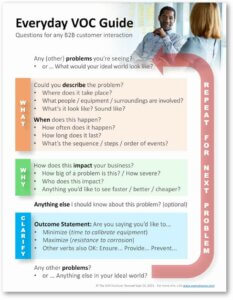 “What” questions. This doesn’t mean your questions start with the word “what,” but rather you’re trying to understand what the problem is all about. Some examples include:
“What” questions. This doesn’t mean your questions start with the word “what,” but rather you’re trying to understand what the problem is all about. Some examples include:
- Could you describe the problem?
- Where does it take place?
- What people are involved?
- What equipment is used?
- When does this happen?
- How often does it happen?
- How long does the problem last?
- What’s the sequence of events?
- “Why” questions. While the “What” questions are for observation, the “Why” questions are for implication: Why does this matter to the customer? Here are some examples of these Everyday VOC questions:
- Why is this a problem for you?
- How does this impact your business?
- Who does this impact?
- How big of a problem is this?
- How severe is this?
- Anything here you’d like to see done faster, better, or cheaper?
- Anything else we should know about this?
- Clarify questions: To clarify the customer’s desired outcome, use an “outcome statement,” a clever approach developed by Tony Ulwick (see What Customers Want). You test what the customer wants, using the format, verb—unit of measure—object. You might ask the customer, “Are you saying you want to…”
- Minimize the time needed for the adhesive to reach full bond strength?
- Maximize the corrosion resistance of your product?
- Minimize the time needed to install this equipment?
- Minimize the overspray of your coating?
- Minimize the training time to reach full competency with this software?
- Maximize the service life of this component?
- Minimize the time required to get a satisfactory technical support response?
After you clarify—and this is very important to Everyday VOC—you ask the customer, “Are there any other problems we should know about?” Then “rinse and repeat” with another round of What-Why-Clarify probing questions.
Then “rinse and repeat” with another round of What-Why-Clarify questions.
Let’s look at the two benefits of using Everyday VOC, beginning with the “let’s-sell-more-today” benefit.
Benefit #1: Greater selling effectiveness
You’re probably familiar with consultative selling, also known as needs-based selling. It’s based on first understanding the customer’s needs or pain points, and then seeking solutions. It was introduced in 1988, with the publication of SPIN Selling by Neil Rackham.
The researchers monitored 35,000 sales calls to determine what the most successful sales professionals were doing. Were they selling features? Nope. Were they promoting customer benefits. Not really. They were asking great questions.
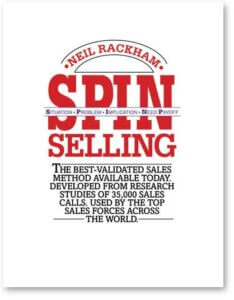 Rackham and his team found that the most effective salespeople asked four types of questions, in this order:
Rackham and his team found that the most effective salespeople asked four types of questions, in this order:
- Situation questions, to understand the customer’s current circumstances.
- Problem questions, to identify problems that the customer is facing.
- Implication questions, to understand the impact of these problems on the customer.
- Need-payoff questions, to explore ways you could help resolve these problems.
Notice that the key to great selling is in your questions. That’s why using the What-Why-Clarify probing questions for Everyday VOC will lead to more sales today. But why do questions lead to sales? There are two reasons.
First, good questions demonstrate you’re more interested in the other person than yourself. What do you call someone who listens to you and seems fascinated by your responses? You call that devoted listener a brilliant conversationalist.
You call that devoted listener a brilliant conversationalist.
Think of it this way: Your customers have a hard time getting their boss to listen to them. They go home and their kids don’t listen to them. Now a sales rep employing Everyday VOC is leaning forward and asking, “Really? Could you tell me more about that?” If you were the customer, wouldn’t you rather buy from this salesperson than one trying to “sell” you something?
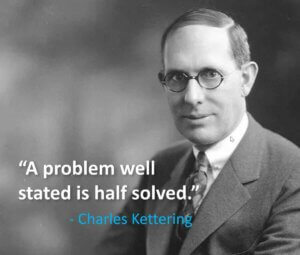 The second reason good questions lead to successful selling is that you must understand a problem before you can solve it. Charles Kettering noted, “a problem well stated is half solved.” If you prematurely converge on what you think the problem is, it’s likely your solution won’t fit.
The second reason good questions lead to successful selling is that you must understand a problem before you can solve it. Charles Kettering noted, “a problem well stated is half solved.” If you prematurely converge on what you think the problem is, it’s likely your solution won’t fit.
When you ask questions to learn exactly “what” the problem is and “why” it matters, you’re better equipped to offer a solution. If this solution is a product or service your company offers, you’ve probably just made a sale.
But wait—there’s more. As sharp as your B2B customers are, they may need some help in clearly articulating the problem. At this point, the Everyday VOC practitioner must behave like a consultant, helping them identify the root problem. That’s why the “clarify” step is so important, and why you should venture a possible outcome statement. Consider this sequence:
- You ask, “Are you saying you want to minimize the time needed for the adhesive to reach full bond strength?”
- They reply, “Well, actually… we just need to quickly get to 50% of the final bond strength so we can start handling the assembly.”
If you’re a salesperson, wouldn’t this understanding help you select the best product for your customer’s application? Beyond this, by recording an accurate customer outcome statement in your CRM system, your company reaps a second benefit from Everyday VOC: data mining.
Benefit #2: Data mining market needs
For many companies, the “promise” of their CRM (customer relationship management) software is still largely unfulfilled. Perhaps you’ve invested in powerful software, such as Salesforce. Are you routinely data mining this huge reservoir of customer visit reports to detect rising market needs, industry trends, and more?
It would be unfair to say the problem is “garbage-in-garbage-out.” If nothing else, the sales rep has a record of past visits to maintain continuity in his or her visits. But if each sales rep enters information into the database in a different way, it will indeed be difficult to convert all this information into actionable company insights. This is a common problem Everyday VOC is designed to overcome.
If you want to turn your sales force into a learning force, you need to make “outcomes” the unit of customer insight. Why are customer outcomes so important? When properly explained—especially with an outcome statement—this tells your R&D or other solution providers exactly what they need to solve with a new product or service.
To turn your sales force into a learning force, make “outcomes” the unit of customer insight.
I didn’t realize how important this data mining was until I was challenged by a client-friend, Fran Behan of Corning. He said, “Dan, if you want your Blueprinting clients to be market-focused, why are you letting them decide when to launch a new-product project instead of the market?”
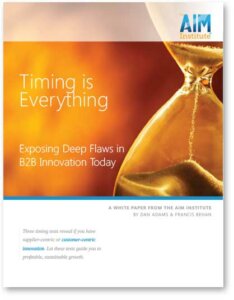 Hmmm… very good point. As a result, Fran and I co-authored a 2015 white paper, Timing is Everything, that proposed a better approach, and eventually led to Everyday VOC. One that relies on data mining your CRM.
Hmmm… very good point. As a result, Fran and I co-authored a 2015 white paper, Timing is Everything, that proposed a better approach, and eventually led to Everyday VOC. One that relies on data mining your CRM.
To see how it works, imagine this scenario: Your company makes glass for phone displays. How important would this outcome be: “Minimize the frequency of glass cracking in phone displays”?
The importance of crack resistance depends on when you ask, doesn’t it? The first cell phones had glass displays that were quite small, so crack resistance wasn’t an issue.
Then glass displays started becoming larger, so phone makers anticipated a problem with glass cracking. As glass began covering the entire phone, cracked glass—with its high warranty costs—became a critical issue.
Then a clever glass supplier—in this case, Corning—developed a much more crack-resistant glass called Gorilla® Glass. As phone producers began using this solution, their intense desire to solve this problem diminished.
If you were a glass producer, when would you want to recognize this rising need for glass crack resistance? Your “sweet spot” would be when customers anticipate the problem.
Now imagine your sales team was employing Everyday VOC and constantly recording customer outcomes after each call. They could send these detailed summaries to their customers, impressing them with their interest and professionalism. And by adding these notes to your CRM, your marketing department or product managers could detect rising needs like this through data mining.
We call this market scouting. It’s an early-warning system from your Everyday VOC that tells your solution-providers when to begin working on a new-product development project or design a new service. In our example of glass cracking, should this send your R&D team immediately into the lab to develop a new glass product? We suggest, “not quite yet.”
Rather, this should be your signal to conduct thorough voice-of-customer interviews for the phone display market. You should do this VOC work in two stages: first a round of qualitative interviews of phone makers, followed by a round of quantitative interviews. In New Product Blueprinting, we call these Discovery and Preference interviews respectively:
- Discovery interviews: You use the same What-Why-Clarify probing, but now you’re hearing from many job functions in many companies in the same time period within the entire market. This highly focused effort will likely uncover additional desired outcomes you should know about, not just glass crack resistance. This lets you avoid errors of omission… failing to uncover unarticulated needs.
- Preference interviews: Here you ask customers to rate several outcomes—including crack resistance—on a scale of 1-to-10 for both importance and current satisfaction. You’ll want to focus on those outcomes that score high in importance and low in satisfaction. You interpret your data using something called a Market Satisfaction Gap chart. (For more, download Market Satisfaction Gaps.) This quantitative, unbiased, unfiltered customer data lets you avoid errors of commission… choosing the wrong outcomes to work on.
These interviews let you avoid errors of omission and errors of commission.
When you conduct Everyday VOC and market scouting, followed by these market-focused interviews, you don’t just work on the outcomes customers truly care about. You work on these outcomes when customers want you to.
You’re now aiming your R&D at precisely the right spot at precisely the right time. Do Everyday VOC well, and you’ll leave your competitors far behind. And you won’t just do it once. You’ll do it every day.
You’re now aiming your R&D at precisely the right spot at precisely the right time.
Learning more
Besides the two benefits covered here, Everyday VOC brings a third “hidden” benefit. When your customer-facing people are continually asking customers about their problems, you change your culture. Instead of being “inside-out,” your organization becomes “outside-in.”
In our experience, this isn’t happening at many companies today. This is good news for yours: There’s still great potential for your company to start Everyday VOC and market scouting to create significant “daylight” between you and your competitors.
The AIM Institute now offers training in Everyday VOC to help you do this. This includes four integrated elements:
- Workshop: 4-hour virtual session with Zoom breakouts for coached role-playing
- Resources: E-learning, knowledge center, and valuable probing aids & resources
- Coaching: 6 monthly follow-up coaching sessions per team to solidify new skills
- CRM advice: Suggestions on how to best use your existing CRM for data mining
To learn more, visit www.everydayvoc.com. Or contact us and we’ll be happy to discuss your specific needs. Don’t be surprised if we ask some good “what” and “why” questions.
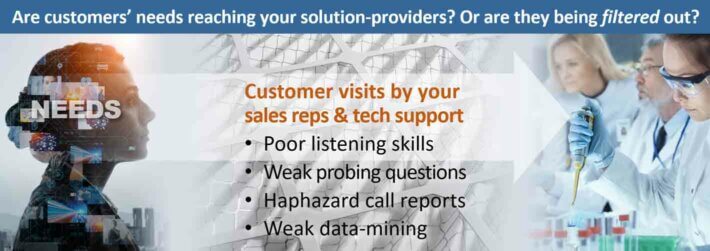
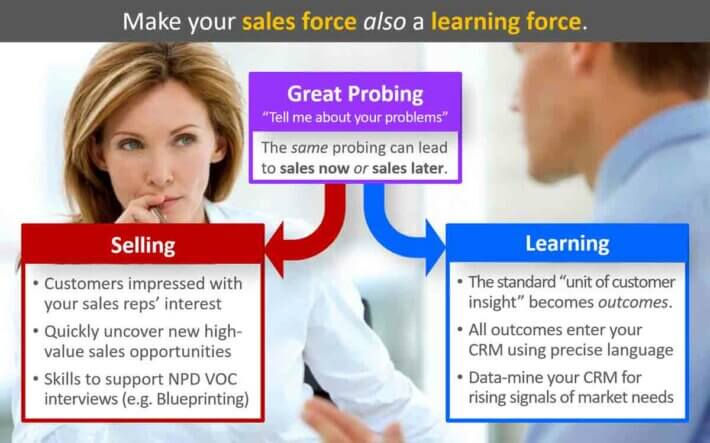
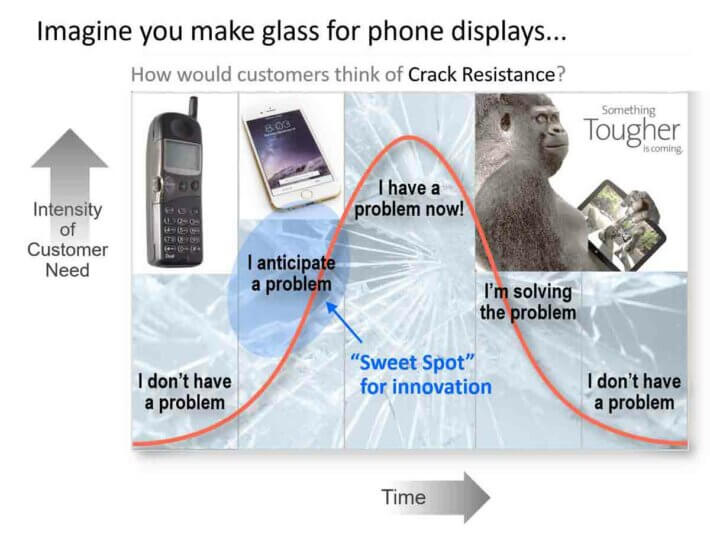
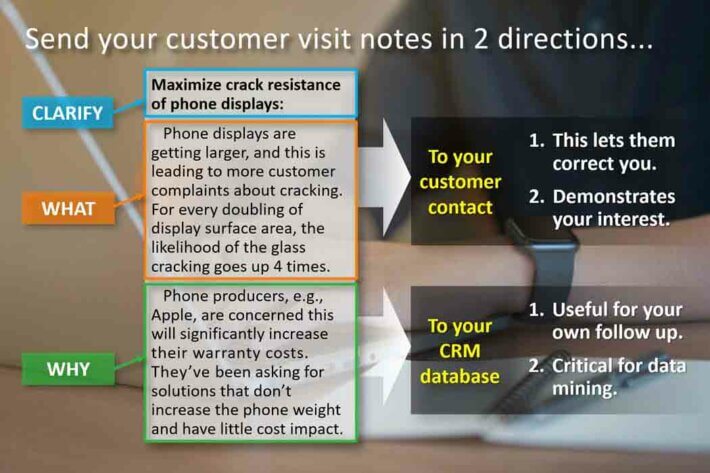
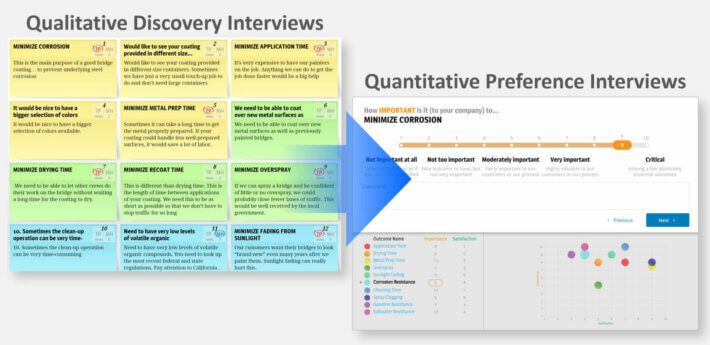
Comments